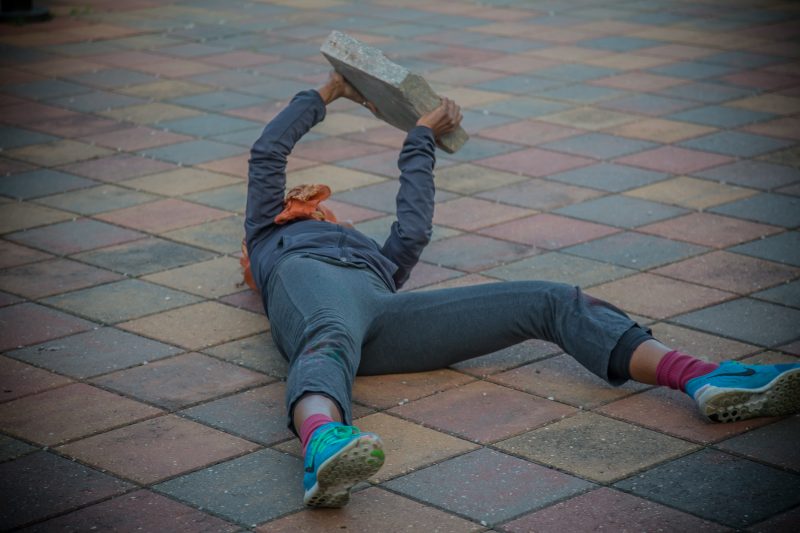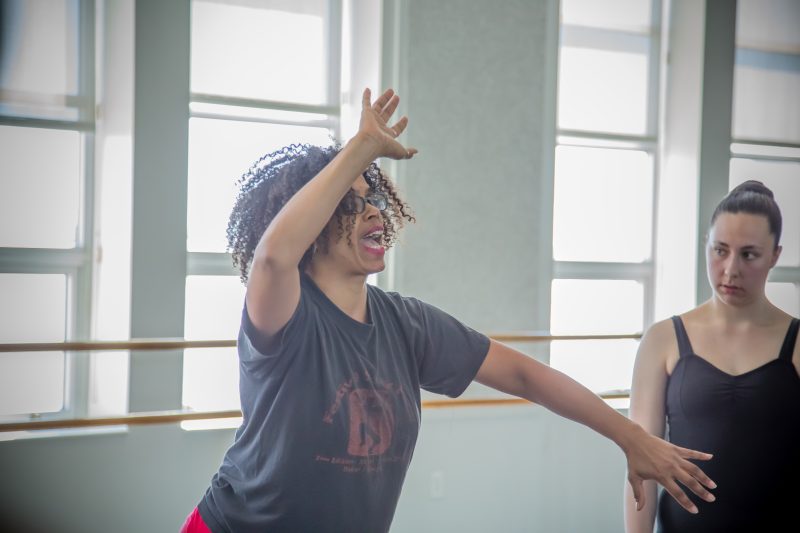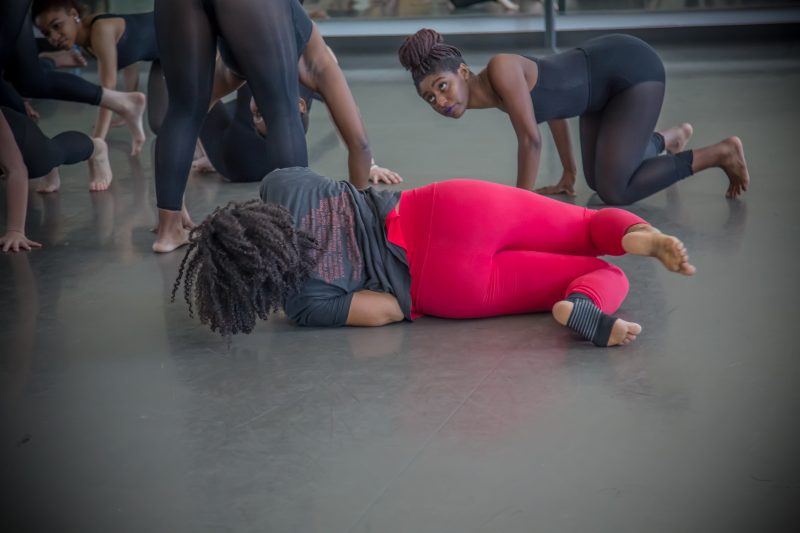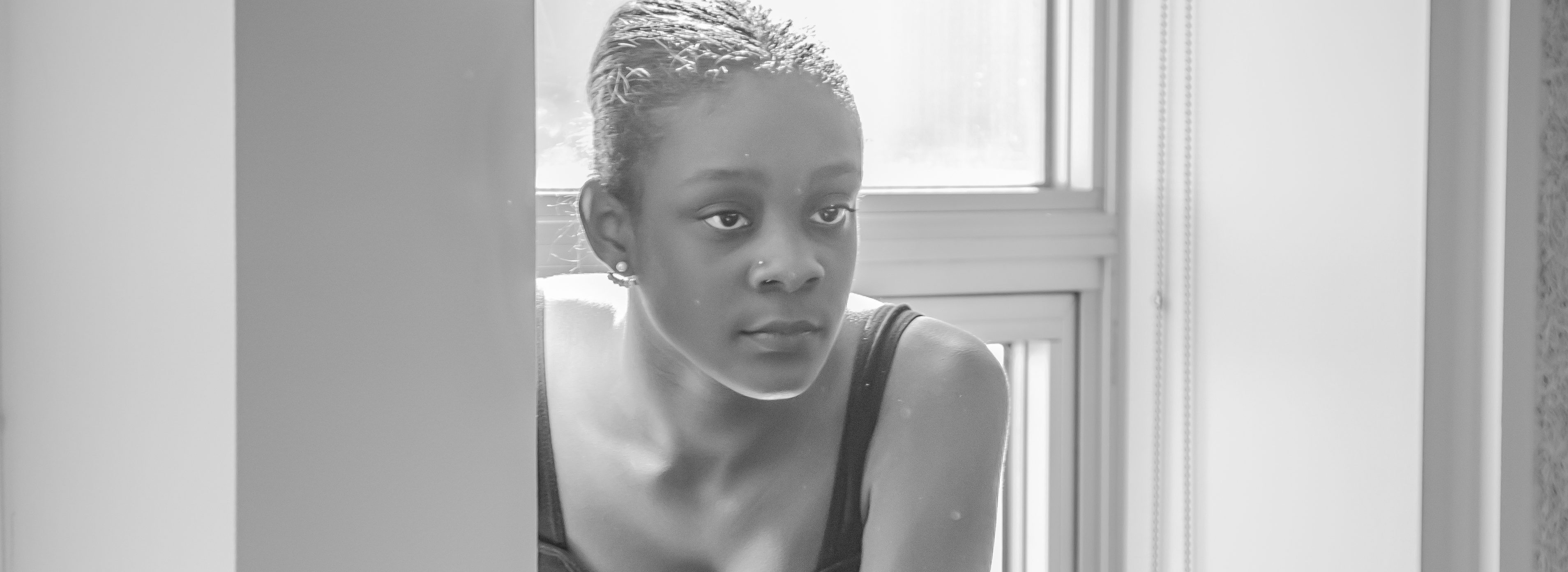An excerpt from EchoSystems: An Ethnography, a series of reflections about the 2015-16 collaboration between Angela’s Pulse and Junebug Productions: Dancing While Black: On Fertile Ground. This residency project brought together four Black women choreographers across three generations of practice to engage with New Orleans arts communities and perform.
slow entrances low swirls pause&rest hold/continue the bodies beg
the bodies beg a question then mingus or one of his suns ripen the air dust foot forehead palm
the face repeats: i know what i know you know what i mean
the body follows
irrespective of rhythm full rest&hold the weight of a mini-verse in palm
then know
they know
are we the crooked ones in this side-ways whirl
the eyes dare to flutter
dare to forget
we have become prone in this perpendicular whirl
the wind our co-assailant feeding us outlaw breath
each swirl repealing a criminal law creeping through the lungs
turn upside down
shake the haints out
jump
jump jump
jump
jump
jump into the afterlife
jump and fly
the one with ribbons circling his feet
does not ride the rhythm
jumps inside the rhythm
submit
surrender
succumb
a body lost and found
insists
resists
emerges at a particularly politically-charged and necessary moment. The tragic murders of Trayvon Martin, Michael Brown, and too many others deeply impacted Black communities globally. Many gatherings provided a space of solace and sharing. Others organized, marched, and confronted local politicians in hopes to affect change.

To be shocked into stillness is a slow death for a movement artist who amplifies the issues of our time through action. With each murder, rigor mortis settles into the bones like psychosomatic cement. With each non-indictment, communities are left to deal with the unravelling of families, the broken hearts of those impacted, and the cultural impact of a country that by and large undervalues Black lives.
Black artists traditionally lead the rallying cry for justice and freedom and are not immune from the impact of repeat instances of environmental racism, Black death, and lack of accountability for the actions of those who vow to protect and serve. In New York, cultural institutions and artists moved between rage, collective action, silence, and a sort of paralysis. Colleagues debated the role of Black dance in addressing issues of violence and institutional oppression. Indeed, many asked, “What is the role of Black artists in times of trauma?” Others challenged artists to assume and sustain roles in subverting and shifting large-scale state violence against Black and Brown youth, men, women, and queer, transgender, and gender non-conforming folks.
Black dancers subvert time and space, work against gravity, and activate new access points while conjuring a reality they choose. Slicing through air, defying balance, and pushing the limits of spirit and body in a world that seeks to restrict one’s movement. They trouble power and positionality in relationship to their environment. As those scores of movements accumulate, the person becomes well-versed in a set of actions that prepares her to aggress against state sanctioned violence.
In Onye Ozuzu’s The Black Saint and the Sinner Lady, presented at On Fertile Ground, audiences witness the impact of re-orienting body and breath. During the performance, I could hear the dancers breathing from the back of the room. Mediated and guttural. Fast and light. Panting and poised. The breath catapults the body and the collective body into a space of new possibilities.

The following transcription provides a look into Ozuzu’s process of compelling the ensemble to activate their fugitive breath in support of re-orienting the world around them.
Onye: …Alright? And then when it’s ready, let go.
SOUNDS OF MOVEMENT.
Onye: How does that—how does that feel?
Ensemble member: Fine.
Ensemble member: …this part. How does it feel to transition into?
Ensemble member: Yeah, there’s like a — I don’t know if you want this specific music cue that we’re using to go from Two Touch to Broken Fall.
VARIOUS VOICES IN AGREEMENT.
Onye: How does it feel…how does it feel—
Ensemble member: It feels…it gets warmer as it goes deeper into it. It starts like…
Onye: The Broken Fall part or the Two Touch part?
Ensemble member: The Two Touch part.
Ensemble member: Yeah.
Ensemble member: I noticed for me, I feel like I have to keep remembering force and direction because, I think, especially for when I get tired, I start to just, like, gasp…then I have to get hype.
VARIOUS VOICES.
Onye: Right. So you’re entering in, try to be with him by the break. I know you’re holding back when you enter. Try to have at least one person by him by the break. Yeah….and it is complicated to be doing Two Touch during that much, having to be that much happening in the music, but you guys can do it.

VARIOUS VOICES AND MOVEMENT. VOICES QUIET INTO MOVING UNTIL ONLY THE SOUND OF SOFT MOVEMENT.
Onye: One, two, three. One, two, three. (Drawn out) Oooooonnneee….(Pause) Two. That’s it, right? One thing that works (Pause) the body can really like… lift it…helps the receiver when the body is falling slowly. It’s like a weird like….like a weird…it’s hard to find to center between giving your weight and holding your weight. It’s like a…. (searching for the word).
DANCERS MOVE.
Onye: As you’re doing that, you continue to turn and change direction. Right? So, remember the image of falling through… like that forest so that there’s like 360 degrees that you can reach by and then you can turn…especially, when you turn your leg and cross, like step your leg over the center. You provide a completely different opportunity for the people if it’s happening slowly. So you keep turning and changing and changing direction with your limbs and making sure that turning throughout the core so that it continues to offer new opportunities. And for those of you who are breaking the fall, remember…remember…it’s the same thing as . . . it’s the difference between hugging someone like this (GIGGLES FROM GROUP) or being really willing to get and become involved in the process. So when we’re not ready, it reads like this.
I know it’s a difficult transition to come in from all this come into (sigh) “I’m here,” but the process and whatever is happening before as you’re coming out has to come to settle you into that. It has to . . . watching him, like by the way that way you watch him . . . be that you’re watching him. You know what I’m saying? Even though you’re not necessarily in the space, but that includes the way you’re starting to reconnect your pelvis to the response mode. The feel–the way he is falling. So by the time you’re coming around, you’re watching, listening with the physicality. Not from holding yourself back. This a tall tale, right? Doing this? Let’s just say that it is not part of your vocabulary, especially that initial contact. That initial contact needs to be, like, much more body-to-body so that from the beginning, you make that magnetic thing sync up. The holding this is the whole body and your direction. Yes.
Ensemble member: Or having it coming from . . . um . . . you putting yourself into motion and being clear about the motion in your whole body and then having the context between you.
Ensemble member: …in body? You know that person. You have to have a feeling and clear direction.
Onye: I’m going to start from the beginning. There was time for one person in the top section…the beginning. For 90 seconds, Paige shouldn’t have to be out there. She was out like half that time. It feels like it’s really really early. Okay, thank you. Ten minutes.
During this process, we witness an ensemble dealing with the complexities of propelling body through time and space in relationship to sound, text, intention, choreography, and community.
Ozuzu pushes them to find each other. Find each other in the fall. Find each other in the rhythm. Find each other in the movement. Find each other through breath. Surely, this is a choreographic imperative, but there is definitely a larger implication given this socio-political and cultural moment in which we are currently living.

Ozuzu pushes them to find each other through motion, to access 360 degrees of possibility, and to reconstruct reality. She admits this task is challenging, but it seems that this notion of conjuring reality with the body and through breath is the major organizing principle for the composition.
Fugitive choreography: The divine right to thrive through the intake of oxygen and the abundant nutrients gifted by the universe. The explicit act of breathing while Black.
